Primitive fire lighting methods
FLINT/STEEL:
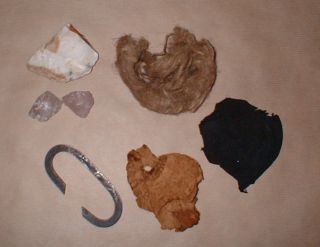
The stone of choise could be quartz, flint (not native in Norway, but I found a fist sized flint nodule on an island by the arctic circle once), or any glassy stone. This only works with a striker of carbon steel, not stainless. I’ve used and old file and quartz with success.
Bits of pyrite also work with steel. Pyrite is quite common, but I`ve never tried it.
To catch the spark it`s easiest using charred cloth (see below how it`s made).
I have no evidence of charcloth being used in Norway.
On the other hand, tinder in Norwegian is called "knusk" and that is also the name of the Fomes Fomentarius.
Horse hoof fungus ( Fomes Fomentarius), "knusk" in norwegian, witch is common in the forests of northern Norway can also be used. Use the brown mid layer (highlighted in red) of the fungus (picture below, right). Picture below, left, shows a Horse Hoof Fungus on a Birch tree.
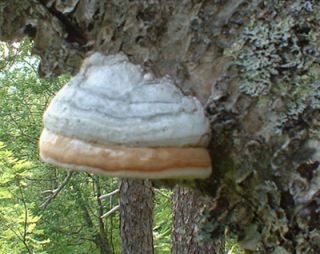
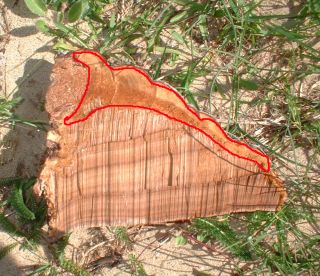
It is best to treat (boil) it with wood ash lye, hammer it flat, dry it and fuzz it (like chenille) to make it work, but it is not neccesary. I`ve used dried and fuzzed "knusk" and it works.
I have also used charred polypore with success. Once I treated the fungus with salpetre and it lighted like a fuse. I actually think it`s too good, burning too fast.
I`ve read books claiming that one can get dry moss, grass etc. to catch spark from a flint and steel combination, but I`ve never succeeded myself.
But I once got a piece of coal (yesterdays fire) from the fireplace take a spark and light a new fire with it.
The best way to transfer the spark from the striker to the tinder is (IMO) to lay the tinder on top, near the edge of the flint, and strike the flint in a downward motion with the striker. If one use charred cloth one can wrap it around the edge of the flint. When the tinder catch a spark you can transfer it to a nest of grass (old birdsnest) or oakum (stry in norwegian) and gently blow it to flames.
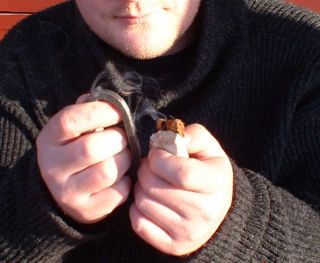
(One of my flint and steel kit contains charred cloth and oakum. The flint is in fact cert from U.S.I bought it on the net from Thomas Elpel. It`s fairly easy to use and contains a user manual, but to begin with a piece of quartz and an old file is enough.)
Charred cloth:
Making charred cloth is not difficult. All you need is a metal can with a lid, and some cotton or linen. Obtain a proper size can and punch a small hole in the lid. I make it from old T- shirts, but old jeans are also very good. Cut the cloth into squares of two inches, or so, and put them in the can (picture below).
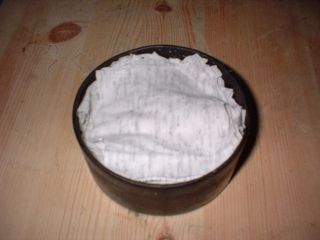
Fill the can, but not so much as to compress the squares. Put the lid on and set the can in an open fire or on a trangia/gas stove. As the can heats, you will see smoke streaming from the hole in the lid (below left).
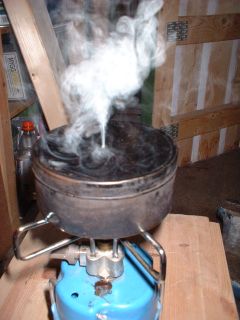
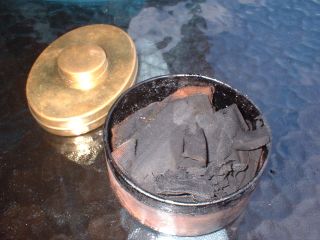
It may catch fire, from time to time. When smoke stops coming from the hole, drag the can off and let it cool. If you open it too quickly, the rush of oxygen will cause the cloth to burst into flame. Once the cloth has cooled, examine it. If you examine mine (above right) you see it is a bit brown, and it could have been heated a little longer. Try catching a spark with it. If it glows it is finished (picture below).
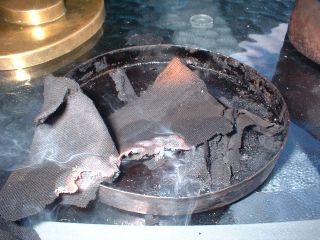
As mentioned above charred polypore also catch sparks.
Bow Drill (Takes some practice to master):
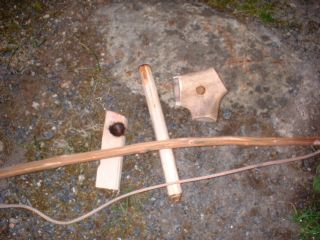
The technique of starting a fire with a bow and drill is simple, but you must exert much effort and be persistent to produce a fire. You need the following items to use this method:
Socket.
The socket is an easily grasped stone or piece of hardwood or bone with a slight depression in one side. Use it to hold the drill in place and to apply downward pressure. I`ve made mine from a reindeer antler (picture above).
Drill.
The drill should be a straight, seasoned “hardwood” (I`ve used willow, Salix caprea, with success.) stick about 2 centimeters in diameter ( I have tried thinner sticks without success) and 25 centimeters long. The top end is round and the low end blunt (to produce more friction). After some times use I cut it down a bit to make friction a little better. You could also carve the drill down a bit on the middle to make a depression for the string. That way it will not move up and down the drill disturbing the drilling.
Fire board.
Its size is up to you. A seasoned softwood board about 2.5 centimeters thick and 10 centimeters wide is preferable. As you see of the picture, mine is just 4cm wide, and 1cm thick. Cut a depression about 2 centimeters from the edge on one side of the board. On the underside, make a V-shaped cut from the edge of the board to the depression. I make my fireboard of birch ( Betula pubescens).
Bow.
The bow is a resilient, green stick about 2.5 centimeters in diameter and a string. The type of wood is not important, but juniper is common and a excellent springy wood. The bowstring can be any type of cordage. A piece of rawhide string works fine ( for practicing one can use any type of string).
You tie the bowstring from one end of the bow to the other, without any slack.
Usage.
To use the bow and drill, first prepare the fire lay. Then place a leaf or a piece of bark under the V-shaped cut in the fireboard.
Place one foot on the fireboard. Loop the bowstring over the drill and place the drill in the precut depression on the fireboard.
Place the socket, held in one hand, on the top of the drill to hold it in position. Support your hand against your leg. Press down on the drill and saw the bow back and forth to twirl the drill. Once you have established a smooth motion, and you see smoke, apply more downward pressure and work the bow faster. This action will grind hot black powder onto the leaf/bark, causing a spark to catch. When you stop drilling the coal (if you got one) will give off a little smoke.
Move the spark to the tinder (a ball of dry grass) and gently blow to ignite. If you don`t succeed, try again.
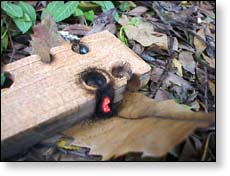
When you first get a spark I find it easier to ignite tinder with it than with charred cloth (flint & steel).
If the friction is too low you can add some fine sand to the fireboards depression. If you fail to produce a coal you may consider using a thicker drill. Works better in humid areas (such as northern Norway).
BURNING GLASS/LENS:
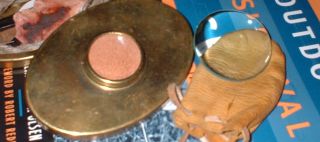
Any convex lens: binocular, glasses, maybe the lens on your SAK. Focus the sunrays and beam onto tinder. The left one on the above picture is a lens on a Hudson bay tobacco tin. The one on the right is an ordinary magnifying glass carried around the neck in a small leather bag.
I`ve used horse hoof fungus as tinder, and just a second of exposure to the sunrays is enough to ignite it. And this was in february when the sunrays are very weak. The burning glass had a diameter of about 4 cm, the glass on the right.
I have later tried the lens on my Suunto MC-2 compass. This was in april and it didn`t work. I think the lens was to small.
The lens of my Hudson bay tobacco tin works though (I live above 67° N). Try for yourself to get an idea of how big it has to be and how much sunshine`s needed.
Burning glass is useless in mid winter above the arctic circle because of lack of sunshine. And many other days of the year.
I would`t use this as my only mean of firelighting.